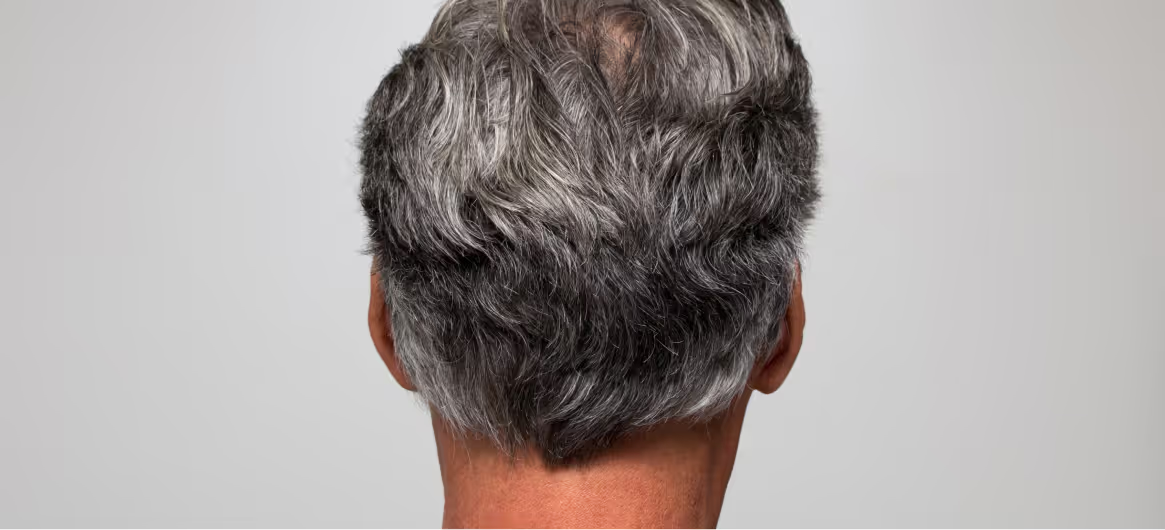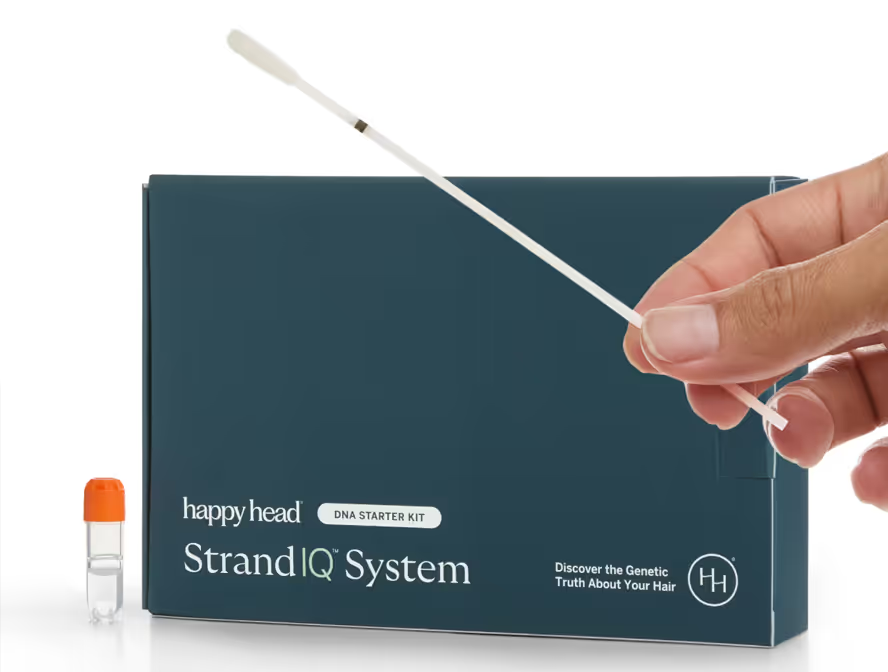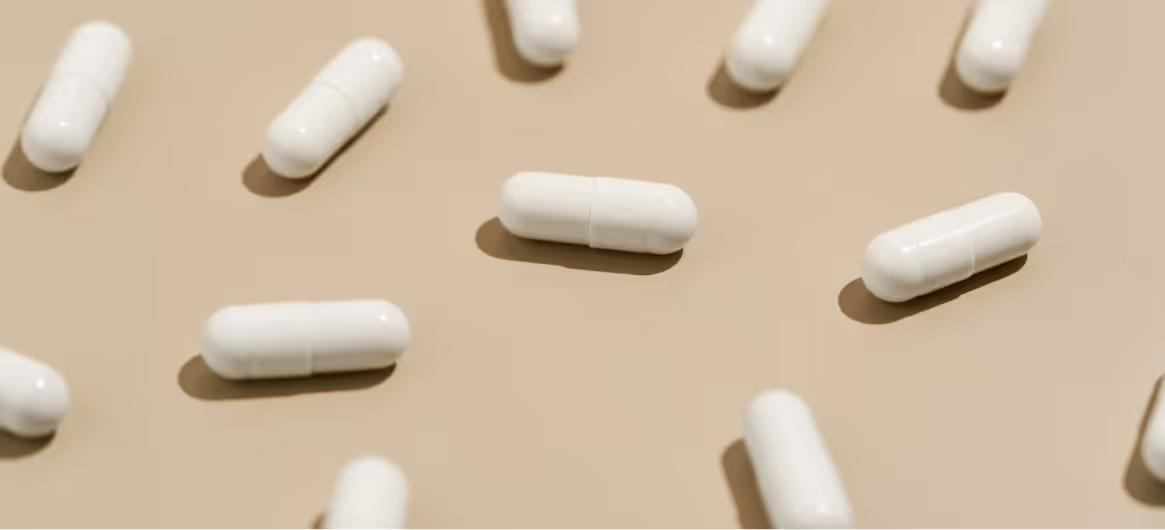It’s estimated that more than 50% of the population will experience significant gray hair by the age of 50—but why it happens (and when) varies widely. Whether your silver strands are sneaking in early or arriving right on schedule, the process behind hair graying is rooted in both science and your DNA.
Let’s take a closer look at why hair turns gray, how genetics influence it, and what you can do—based on your personalized Happy Head StrandIQ™ profile—to support healthy pigment production.
What Causes Hair to Turn Gray?
Hair gets its color from melanin, the pigment produced by melanocyte cells in the hair follicle. As we age, melanin production slows down. But that’s not the only reason for graying.
In many cases, a buildup of hydrogen peroxide inside the hair shaft, often caused by oxidative stress, interferes with melanin synthesis. The result: gray or white strands.
And while graying is part of the natural aging process, it can also be influenced by other factors, including:
- Genetics
- Stress
- Nutrient deficiencies (especially B vitamins, copper, and glutathione)
- Medical conditions, like autoimmune disorders or thyroid issues
What’s considered premature graying can depend on your background. For example, in white individuals, gray hair before age 20 is considered premature, while for Asian and Black individuals, graying before ages 25 and 30, respectively, is considered premature.
How Your DNA Influences Graying Hair
If your parents or grandparents went gray early, chances are you might, too. Genetic variants near IRF4, BCL2, and MC1R genes have all been associated with earlier onset of hair graying. These genes regulate pigmentation and melanocyte survival, directly impacting your ability to maintain natural hair color.
Your StrandIQ analysis can help pinpoint whether you have a higher genetic propensity for early graying—allowing you to adjust your care routine and nutrition accordingly.
Hair graying Treatment Options, Based on Risk Level
While you can’t turn back your DNA, there are lifestyle shifts, supplements, and even cosmetic choices that can help manage graying, particularly when it starts early.
Low-Risk: Healthy Habits to Support Hair Pigment
If your Happy Head StrandIQ™ analysis has identified you as being at a genetically low-risk for premature graying, small shifts can help make the difference in preserving your natural color for longer:
- Boost protein intake
Hair is made of a protein called keratin. Eating enough protein ensures your body has the building blocks for healthy hair growth and may help to slow the graying process. - Manage stress
Research suggests chronic stress accelerates graying by impacting stem cells in the follicle. To help better manage your stress levels, consider calming practices like yoga, meditation, or journaling. - Get your vitamins
Focus on micronutrients like biotin, vitamin B12, folic acid, copper, and glutathione. These help support melanocyte function and antioxidant defenses.
Medium-Risk: Take a Targeted Approach
If your DNA or lifestyle puts you at medium risk, it’s time to get a little more proactive:
- Consider supplements
If it’s tough to get nutrients from diet alone, look for a multivitamin that includes B12, copper, and folate. - Be strategic with stress
Techniques like box breathing or even short daily walks can lower cortisol and reduce oxidative stress. - Talk to your doctor
If you’re graying well before your peers, a physician can help rule out underlying conditions like anemia, thyroid issues, or autoimmune diseases. - Try dye—if it makes you feel good
gray is beautiful, but so is owning your style. If gray hair makes you feel less like yourself, coloring is always on the table.
High-Risk Options: When Early or Rapid Graying Needs a Closer Look
If your StrandIQ results indicate a high risk for premature graying—or if you’re noticing significant changes in color earlier than expected—it may be time to go beyond basic lifestyle tweaks. At this stage, more targeted strategies can help address underlying biological factors contributing to melanin loss.
- Consider antioxidant therapy
Excess hydrogen peroxide buildup in hair follicles is one of the known causes of premature graying. Talk to your healthcare provider about antioxidant support such as catalase, NAC (N-acetylcysteine), or glutathione supplements. These may help break down oxidative buildup and protect follicular pigment cells. - Evaluate your underlying health factors (e.g., thyroid and autoimmune markers) that may affect hair appearance
Premature graying—especially before age 25—can sometimes signal underlying autoimmune or thyroid dysfunction. Bloodwork to check for Hashimoto’s, Graves’ disease, or thyroid imbalances may uncover a root cause that may be addressable with medical treatment. - Look into peptide-based topical solutions
Emerging treatments using peptides and stem cell-stimulating compounds are being researched for their ability to prolong melanocyte (pigment cell) activity. These are typically prescription or clinical-grade and may be used under a dermatologist’s supervision. - Psychological and emotional support
If rapid graying is impacting your confidence or emotional health, don’t dismiss that experience. A therapist, support group, or even lifestyle coaching may help you navigate the change with more resilience—and less stress, which itself can worsen the problem.
Your Path Forward: How to Manage and Slow Premature Hair Graying
While graying is a natural part of aging, understanding why it happens—whether due to genetics, stress, or nutrition—can help you take control of the process. Small changes, like boosting protein and key micronutrients or managing stress more effectively, can make a measurable difference, especially when tailored to your risk level.
If you’re experiencing early or rapid graying, it’s worth exploring targeted strategies with your healthcare provider. From lifestyle adjustments to clinical support, there are actionable steps you can take to slow the process, support overall hair health, and feel more confident about what’s next.
References
StrandIQ SNP Marker Count: 5
StrandIQ Genes for Trait:
ADAM28, ADAM7-AS1, FAM13A, HJURP, MROH2A
References:
Adhikari, K., et al. (2023). Genetics of hair graying with age. Mechanisms of Ageing and Development, 213, 111792.
Bian, Y., et al. (2019). Global downregulation of pigmentation-associated genes in human premature hair graying. Experimental and Therapeutic Medicine, 18(2), 1155–1163. PMID: 31316609.
Desai, D.D., et al. (2025). Premature hair graying: a multifaceted phenomenon. International Journal of Dermatology, 64(5), 819–829.
Pośpiech, E., et al. (2020). Exploring the possibility of predicting human head hair greying from DNA using whole-exome and targeted NGS data. BMC Genomics, 21(1), 538.
This content, including StrandIQ™ DNA analysis reports and any Happy Head products and/or services referenced therein, is for informational and cosmetic purposes only. It is not intended to diagnose, treat, cure, or prevent any disease. This content does not constitute medical advice and should not be used to make healthcare decisions. References to prescription treatments are educational in nature. Always consult a licensed healthcare professional for any medical concerns or treatment decisions.








.avif)

